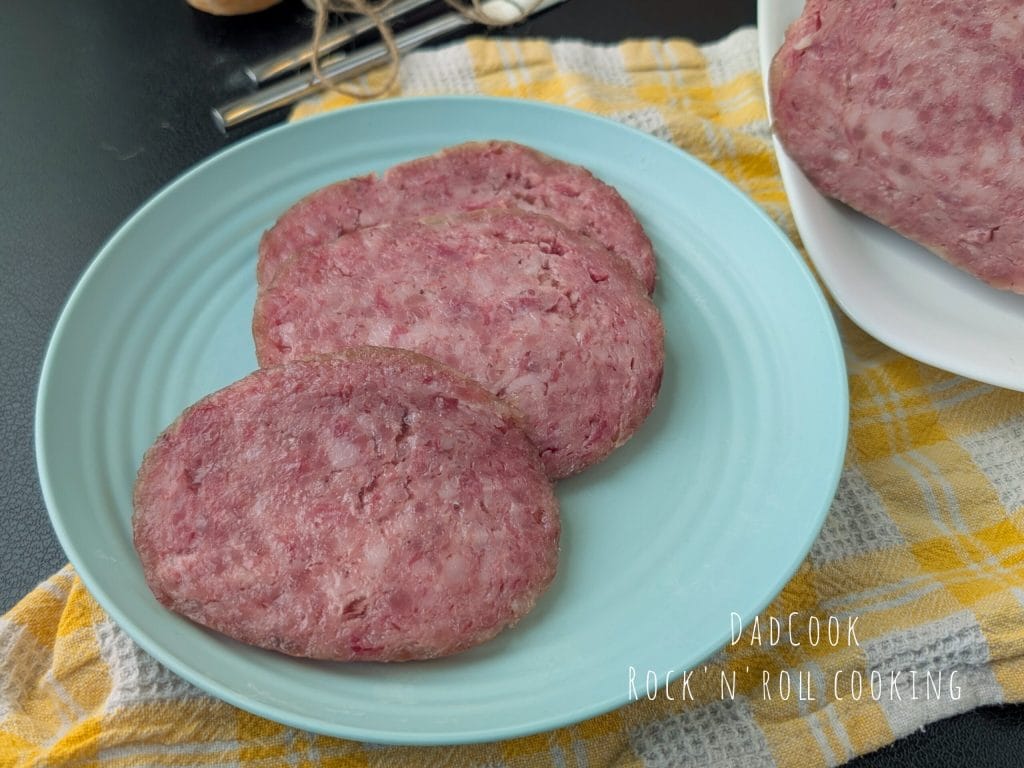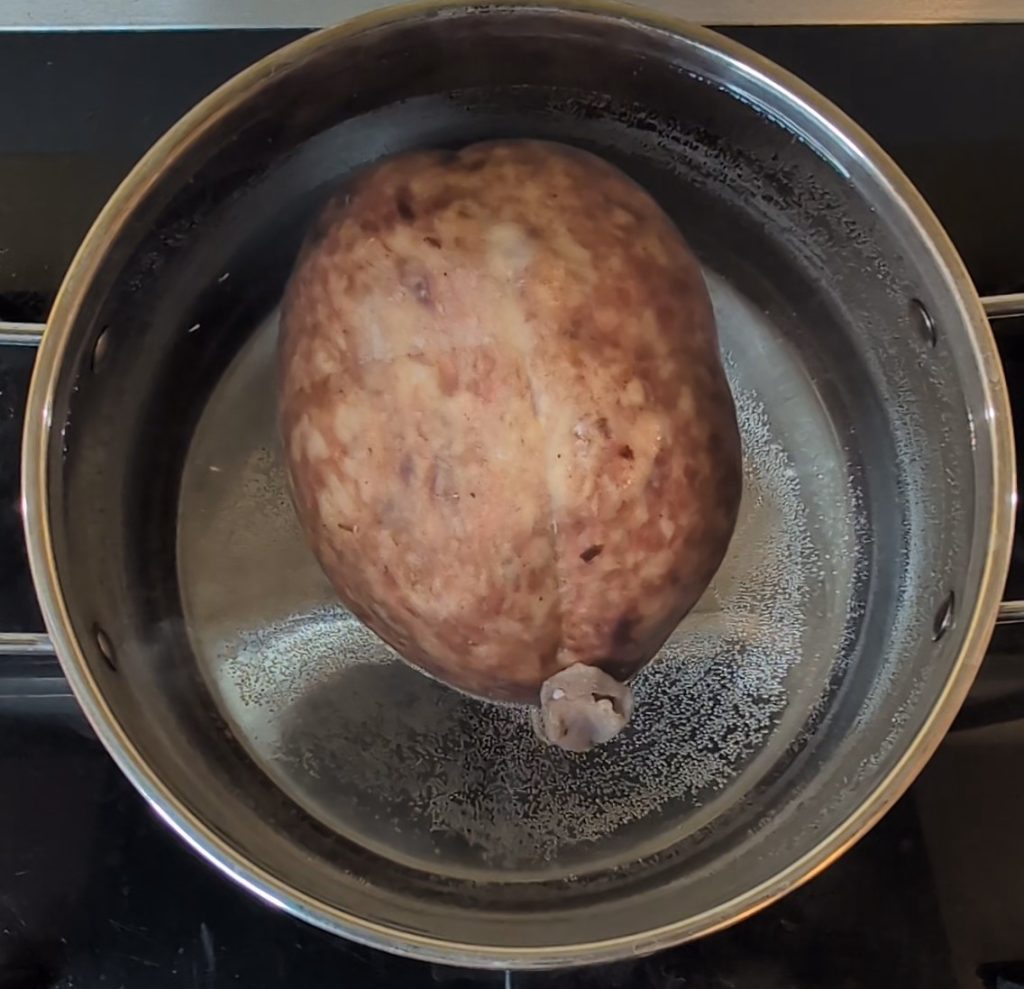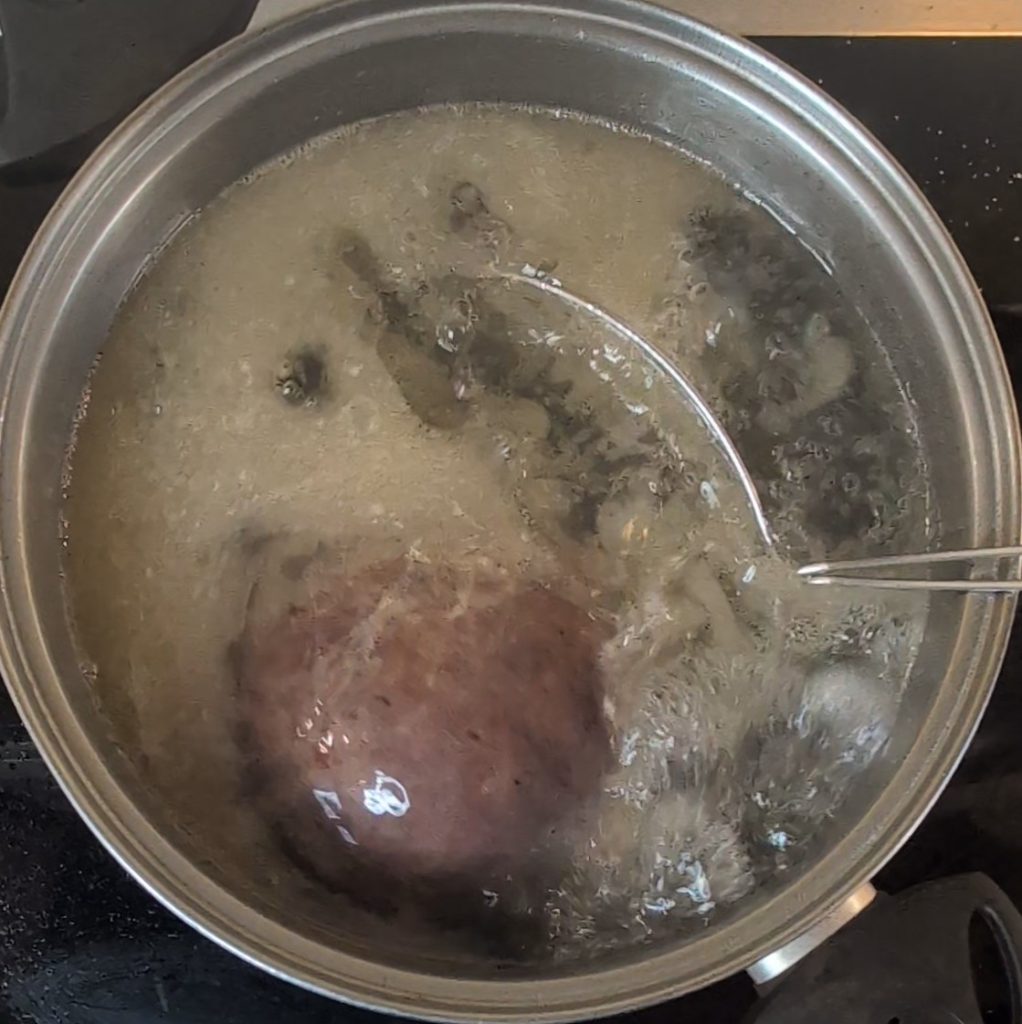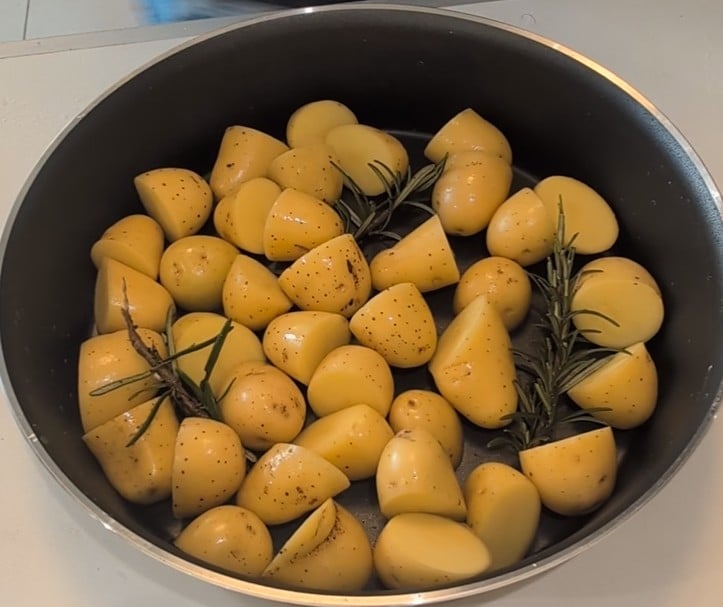The Cremonese Boccia, queen of Lombardy’s winter tables, is an ancient recipe rooted in rural tradition. Imagine the cold days of the past when skilled butchers, with expertise passed down through generations, transformed pork meat into delicacies to be savored during the holidays.
This sausage, similar to the cotechino but larger and aged, owes its name to the casing in which it is traditionally stuffed: the pig’s bladder, known as the “boccia.”
At one time, it was customary to prepare it at home, with a ritual involving the whole family.
Today, fortunately, we can find it at trusted butchers and delicatessens, ready to be enjoyed. Its soft texture and rich, spicy flavor make it perfect for accompanying typical winter dishes like lentils, mashed potatoes, and mustard.
Preparing the Cremonese Boccia is a gesture that brings warmth to the table and the authentic taste of Lombardy.

- Difficulty: Very easy
- Cost: Inexpensive
- Rest time: 10 Minutes
- Preparation time: 5 Minutes
- Portions: 8
- Cooking methods: Boiling, Slow cooking
- Cuisine: Italian
- Seasonality: Autumn, Winter, New Year's Eve
Ingredients
- 1 Cremonese Boccia
Tools
- 1 Pot
Steps
Let’s start preparing our Cremonese Boccia!
The first step to enjoying this delicacy at its best is to prepare it carefully. Take our Boccia and, at room temperature, make small holes all over the casing with a toothpick or a thin needle.
This simple precaution will prevent the casing from breaking during cooking, preserving its shape and consistency.
Next, take a pot large enough to completely submerge the Boccia and fill it with cold water.

Due to its considerable size, the Cremonese Boccia requires a two-phase cooking process for optimal results, reducing excess fat and maintaining its softness.
Proceed with the first boiling: immerse our Boccia, after carefully perforating it, in the pot filled with cold water. Place the pot on the stove and bring the water to a boil. As soon as the water boils, reduce the heat to the lowest setting, cover the pot with a lid, and let it cook for at least 4 hours. The lid will help maintain a constant water level and promote even cooking.
After 4 hours, prepare a second pot with hot water. Gently lift the Boccia from the first pot (now rich in fat released during cooking) and transfer it to the new pot with clean water.
Continue cooking for about another half hour, always over low heat and with the lid on.
This final stage will allow us to complete the cooking of the Boccia, eliminating excess fat and achieving a more delicate flavor.

Once the second boiling is complete, remove the Boccia from the water and let it cool for a few minutes.
This step will make it easier to remove the casing. Gently start peeling the casing away from the Boccia’s surface, using a knife if necessary.
Carefully proceed, completely removing the casing until you have a beautiful salami with a compact shape and pink surface, ready to be sliced and enjoyed!

After carefully removing all the casing, our Cremonese Boccia stands in all its glory, ready to be sliced and savored!
If we wish to serve it immediately, we can cut it into slices about a half-inch thick with a sharp knife.
Accompanied by a side of lentils and a spoonful of Cremona mustard, it will be a triumph of flavors! If instead, we prefer to prepare it in advance, for a buffet or an appetizer, we can let it rest in the refrigerator for at least 8 hours. After this time, with the help of a slicer, we will obtain thin and delicate slices, perfect to be enjoyed naturally or used to fill sandwiches, crostini, and canapés.
The Cremonese Boccia lends itself to endless interpretations, let your imagination inspire you!

The Cremonese Boccia, as we have seen, lends itself to various culinary interpretations.
Besides the classic pairing with lentils and mashed potatoes, we can get creative and serve it in many different ways.
For example, thinly sliced it is an appetizing starter when paired with aged cheeses, fruit mustard, and toasted bread. It’s also ideal as a filling to enrich sandwiches, club sandwiches, and wraps, perhaps with the addition of grilled vegetables or sauces of your choice.
For the more creative, it can become a special ingredient as a filling for savory pies, a condiment for fresh pasta, or a base for flavorful sauces.
Let your imagination inspire you and experiment with new flavor combinations!
Remember that the Cremonese Boccia can be enjoyed either warm, just sliced, or cold, like a traditional salami.
Choose the mode you prefer and satisfy your taste needs.
Enjoy your meal!

Here are some tips for best preserving your Cremonese Boccia and some tasty variations to enjoy it:
Preservation:
After cooking: Once cooked, the Cremonese Boccia can be stored in the refrigerator for 3-4 days, wrapped in aluminum foil or plastic wrap.
In the freezer: For longer preservation, you can freeze the Cremonese Boccia, either cooked or raw. If you freeze it raw, remember to thaw it completely in the refrigerator before cooking. If you freeze it cooked, you can slice and consume it cold or warm it slightly.
Vacuum-sealed: For optimal preservation and to extend shelf life, the best method is vacuum-sealing. This way, the Cremonese Boccia will maintain its taste and texture for several weeks in the refrigerator.
Variations:
With chestnuts: A classic and autumnal pairing is with boiled or roasted chestnuts. The sweet and delicate flavor of chestnuts pairs perfectly with the intense taste of the Boccia.
With polenta: Another tasty alternative is to serve the Cremonese Boccia with polenta, either grilled or creamy. A rich and substantial dish, perfect for cold winter days.
Stewed: For a more elaborate dish, you can use the Cremonese Boccia to prepare a stew with seasonal vegetables, such as potatoes, carrots, and onions. A dish rich in flavor and tradition, perfect for a family lunch.
With mushrooms: A refined and flavorful pairing is with sautéed or porcini mushrooms. The intense taste of mushrooms pairs perfectly with the richness of the Cremonese Boccia.
I hope these tips are helpful to you! 😊
Wine to pair with Cremonese Boccia:
Here are 5 wines that pair excellently with the Cremonese Boccia, enhancing its rich and spicy flavor:
Lambrusco di Sorbara (Emilia Romagna): A sparkling red wine, fresh and lively, with pleasant acidity that balances the fatness of the Boccia. Its fruity notes of cherry and strawberry harmonize with the spices of the sausage, creating a harmonious pairing.
Bonarda dell’Oltrepò Pavese (Lombardy): A still red wine, with a young and fruity character, soft tannins, and good structure. Its notes of red fruits and spices pair well with the Cremonese Boccia, creating a territorial and characterful pairing.
Gutturnio (Emilia Romagna): A still red wine, full-bodied and structured, with aromas of ripe fruit, spices, and licorice. Its complexity and aromatic persistence pair well with the richness of the Cremonese Boccia, creating an intense and satisfying pairing.
Merlot del Veneto (Veneto): A still red wine, soft and velvety, with aromas of plum, cherry, and chocolate. Its elegance and roundness harmonize with the Cremonese Boccia, creating a refined and pleasant pairing.
Grignolino del Monferrato Casalese (Piedmont): A light, fresh, and aromatic red wine, with notes of rose, raspberry, and pepper. Its drinkability and aromaticity make it an interesting pairing for the Cremonese Boccia, especially when served cold or as an appetizer.
Tip: If possible, choose wines produced in Lombardy or nearby regions to create a territorial pairing that enhances local products.
FAQ (Questions and Answers)
Here are some frequently asked questions and answers about the Cremonese Boccia:
What is the difference between Cremonese Boccia and cotechino?
The Cremonese Boccia is similar to cotechino but generally larger and aged. Also, the Boccia’s filling has a coarser texture and often includes pork cheek.

How is the Cremonese Boccia cooked?
It is cooked by boiling it in water for several hours, preferably in two stages to reduce fat. It is important to pierce the skin before cooking to prevent it from breaking.

How long does it take to cook the Cremonese Boccia?
The cooking time varies depending on the size, but generally, it takes at least 4-5 hours.

Can I cook the Cremonese Boccia in a pressure cooker?
No, it is not recommended to cook the Cremonese Boccia in a pressure cooker. Unlike cotechino, Boccia has a softer consistency and higher fat content. Pressure cooking, with its speed and intensity, could cause the casing to break and compromise the product’s shape and flavor. The best method to cook the Cremonese Boccia is the traditional way in boiling water, with the double-stage process we described earlier. This allows for uniform and gentle cooking, preserving its integrity and taste.

What is the Cremonese Boccia served with?
Traditionally, it is served with lentils and mashed potatoes, but it also pairs well with polenta, mustard, vegetables, and mushrooms.

Can I freeze the Cremonese Boccia?
Yes, you can freeze the Cremonese Boccia either raw or cooked. If you freeze it cooked, you can slice and consume it cold or warm it slightly.
How do you store cooked Cremonese Boccia?
It can be stored in the refrigerator for 3-4 days, wrapped in aluminum foil or plastic wrap.
Where can I buy Cremonese Boccia?
The Cremonese Boccia can be found at butcher shops, delicatessens, and specialty food stores, especially in Lombardy.
Is the Cremonese Boccia gluten-free?
Yes, generally the Cremonese Boccia is gluten-free, but it’s always best to check the label to be sure.
Is it possible to make Cremonese Boccia at home?
Yes, it is possible, but it requires time and some experience in working with meats. There are various recipes online and in traditional cookbooks.
Is the Cremonese Boccia a high-calorie product?
Yes, like most sausages, it is a high-calorie product rich in fats. It is advised to consume it in moderation.

What are the origins of the Cremonese Boccia?
The origins of the Cremonese Boccia are lost in Lombardy’s rural tradition. It was once a typical product of the winter period and the Christmas holidays, made at home with pork meat.

